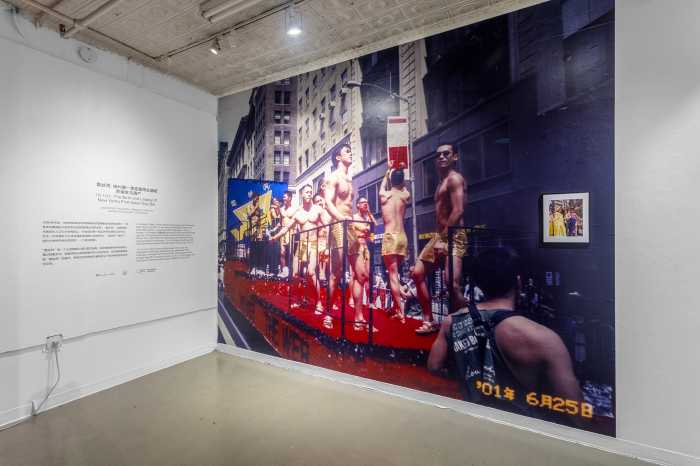By Stephanie Buhmann
Unpacking the work of sculptor John Newman
Over the past three decades, sculptor John Newman has explored a wide range of materials, which he has formed, shaped and re-assembled into works that are exquisitely mysterious and hard to categorize.
In the mid-1990s, Newman shifted his focus from the large-scale works for which he had become known to intimately sized sculptures that required the direct touch of the hand. His latest exhibition features recent small-scale works, well displayed on a table that was specially designed for this occasion.
These “Instruments of Argument” wear their quirks with confidence. They are at ease; indulging in a beauty that often embraces the bizarre, be it through a screeching color scheme or dramatic surface textures. Newman is unafraid of surprises and it is not unusual to find the unexpected, such as a red flying carpet adorned with fake green leaves cantilevering from a skeleton of a shell; or braided brass wires oozing from glass orbs that wrap themselves around a crumpled sketch of the sculpture’s construction.
Each work challenges our imagination and remains freely interpretive. The pieces possess an almost magnetic pull. It is easy to be enamored of them and yet, they remain hard to pin down. Their exploration requires intimacy and imagination. The viewer has to get as close to them, according to Newman, as one only gets to “food, babies, a lover or a book.” Our senses on this quest of discovery bring us to the point that the desire to sneak a touch becomes nearly unbearable.
In meeting with John Newman shortly after the opening of his first New York solo show in five years it becomes apparent out that, to him, the space of the imagination is one of the most crucial aspects sculpture has to offer.
Courtesy of the artist
Open pink with signs of life, 2006
Stephanie Buhmann: The works in this show are all intimately scaled, a sentiment that was also reflected in some of your recent exhibition titles, such as “Homespun” and “Monkey Wrenches and Household Saints.” How did you shift your interest from large to smaller scaled works?
John Newman: It began when I was first teaching at Yale in the early 1990s. I was struck that all my students were making research-driven installations. I was interested in this notion that installation seemed to subsume the basic premises of sculpture. Sculpture all of a sudden felt like a subset of installation, as opposed to sculpture in the 1970s, when sculpture-as-a-field was a big welcoming “umbrella,” sheltering beneath it everything that was not painting — performance, earthworks, video, and even some photography. As sculpture welcomed more extended activities, the object seemed to many people less and less engaging; barely creditable. I began feeling dissatisfied with what I was seeing. After I left teaching, I traveled extensively. I went to India, Africa and Japan. What I realized was that people in these countries had very important relationships with objects that were small in size, but not at all small in significance — objects like a Japanese teacup or a Congo Power god; the equivalent of a household saint or a carved stone, covered in flowers and milk and honey, in a village in India. There was an intimacy inherent in these small objects — and this intimacy, clearly, elicited feelings of import — emotions greater than their physical size would appear to demand. This seemed quite the opposite of things I had been seeing in Chelsea. I began to think, like a farmer might, that if everyone was planting their corn on one side of the hill, possibly the minerals were being depleted and it would be curious to see what happened if I planted my corn on the other side of the hill. So I began making these small objects based upon these little drawings I was doing, which was the only thing I really could do while I was traveling.
SB: Do you ever think of these works as models for larger sculptures?
JN: No. In fact, that question leads me to something I like to call “the scale-less object.” All Western sculpture has been more or less based upon body relationships — and truth to the materials, with an emphasis on gravity and weight. But there is another branch of sculpture that has not been absorbed as much into the mainstream of history. It is based on the idea that certain objects are what I like to call “scale-less” — more about your relationship with the object in the realm of the imagination, rather than fundamentally a physical rapport. This work often uses bright color, light-weight materials and disparate constructed parts. Calder and Cornell are very different, but each demonstrate this idea quite well. The globe of the world, for example, represents a good model for the “scale-less” object. You see the globe of the world as a sign for the very thing that you can’t see fully, but that you know very well. However, it is an instrument with an expectation of information, as well as an instrument of fantasy, of reverie. It is not primarily about your proximal or kinesthetic relationship to the object itself, or the actual space you share with that object. The DNA model or Chinese Scholar’s Rocks are also examples of these scale-less instruments of reverie. Imagination as “dreamscape” is a space infinitely big, even if it is provoked by an object significantly small.
SB: Unpredictable is an adjective often applied to your work and the sculptures in this exhibition, as well, offer plenty of riddles regarding their physical nature.
JN: Yes, these sculptures are very much in contrast to the usual concepts of gravity and truth to the material. I would like my works to be more buoyant, more illusionistic, although usually we associate terms like that — at least in the visual arts — with the territory of painting.
SB: It gives them a magical quality, defying the common sense of what is possible.
JN: There is a contradictory element in my work; paradoxical and even fictional — as strange as that sounds — since an object is a concrete thing. But to actually turn that idea upside down and to wonder how something is “actually there” is of interest to me. The same applies to the material. In these works, you often do not know what material the parts are made of. And, yet, another component joined to one of these parts will be absolutely obvious as to its material and its making. I think of processes and materials as metaphors — fraught with meaning and association — and by placing disparate ones together, I hope to achieve a resonance not unlike the ringing of a tuning fork that will create a third-thing, an invented, unknown and un-nameable consequence of that conjoining.
SB: Let us speak about the concept of intimacy in relation to your work — the notion that one has to get incredibly close to engage with them. Intimacy can lead to the thorough knowledge of something or someone, but it also requires self-reflection. In the case of your work, it seems both viewer and object are significant parts of the same discovery.
JN: Yes, that’s what intimacy is; a discovery made together, because you are giving up something in exchange for something you gain. I could compare it to two dogs approaching one another, you don’t know if you will be bitten or licked. There is danger, anxiety, humor and joy all wrapped together. If your position is nose to nose, there is no peripheral vision. You are too close. In addition, your way of looking becomes very feeling-full and, I hope, emotional — not in a literal “this story made me cry” way, but in a way that only intimacy can bear. That is the quality that interests me. Basically, I want the viewer to think, “What is this thing and what am I doing here asking the question, ‘what is this thing’? If one can extend that thought then one might ask, ‘what am I doing here’? And then, when one encounters things out in the world that are unfamiliar there might be a funny little echo, a memory of the encounter with this sculpture to help you unlock and unblock other things unknown. The sculptures then, at best, become instruments of consciousness-raising.




































